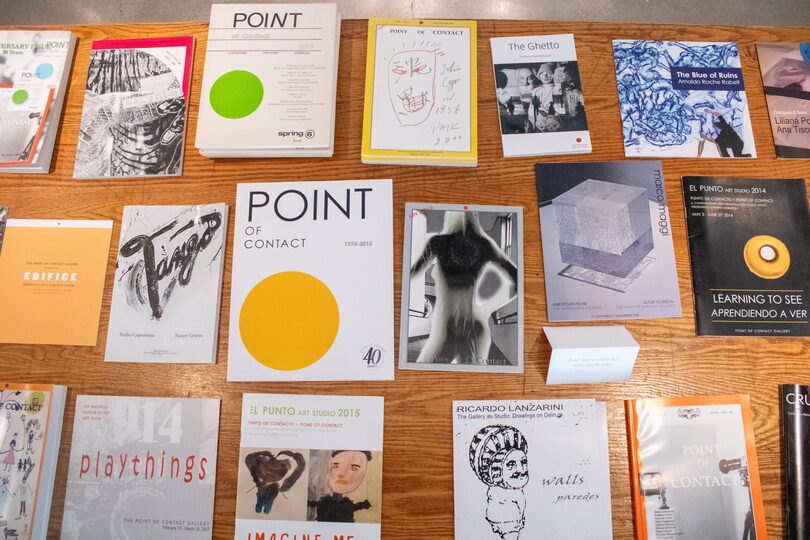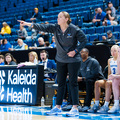Point of Contact’s 50-year history symbol of union between diverse creatives, art

Point of Contact was ideated by the late Pedro Cuperman, a Syracuse University professor of Latin American literature, bringing literary journals, poetry readings, art galleries and more to Syracuse. Cuperman saw beauty and art in everything, his longtime friend said. Leonardo Eriman | Photo Editor
Get the latest Syracuse news delivered right to your inbox.
Subscribe to our newsletter here.
In 1975, Pedro Cuperman was missing the art and culture of his home country of Argentina. Combining his love for literature, research and visual art, he looked to bring this culture to New York. Soon, Punto de Contacto/Point of Contact was born.
Half a century later, the organization is bigger than one man’s legacy, Samantha Hefti, the archivist and collections manager, said.
“This is all a product of human work and imagination,” said Teresita Paniagua. “It’s important to mark the passage of time, where we come from and where we are now.”
Point of Contact celebrates its 50th anniversary this year. Throughout the years, the organization has become a prevalent part of SU’s art scene with literary journals, youth and adult programming, art galleries and poetry readings.
The 50th anniversary of their first literary edition in October 2025 coincides with Latine Heritage Month. The celebration gives their program a heightened level of visibility, Paniagua, SU executive director of the Office of Cultural Engagement for the Hispanic Community, said.
Point of Contact’s current exhibit, “50 Sin Cuenta,” is on display in the Nancy Cantor Warehouse until late October. It showcases Latin American artifacts and art pieces from Point of Contact’s permanent collection that represent the organization’s history.
The organization is the brainchild of the late Cuperman, an SU professor of Latin American literature. His vision for Point of Contact was a “cross pollination of different disciplines,” Breyer said. Its essence is celebrating art for art’s sake.
Cuperman saw beauty and art in everything, even in the mundane or unfortunate, Richard Breyer, SU professor and longtime friend of Cuperman, said.
Breyer and Cuperman’s relationship began when Breyer became involved in Point of Contact’s “10 to 10 to 10” project in the 1990s. Ten colleagues from SU each chose 10 minutes of TV media and reflected on it through the lens of their personal stories or academic discipline.
During the final presentation, 10 projectors showed the videos as each person spoke. After working on “10 to 10 to 10,” Breyer was hooked. He began reading Point of Contact’s literary journal and attending poetry readings and exhibits.
Breyer said he remembers driving Cuperman to the airport as he left Syracuse for Buenos Aires, where he later died in 2016. Breyer knew it would be the last time he saw him, and relished in the last glimpses of Cuperman’s apartment, decorated with telescopes, sculptures, stained glass and poetry on a blackboard.
With this visit, he said goodbye to his dear friend. Point of Contact’s 50th anniversary exhibit event felt like saying “hello to him again,” Breyer said.

“50 Sin Cuenta,” the current exhibition celebrating Point of Contact’s 50th anniversary, highlights Latin American artifacts and pieces. The anniversary coincides with Latine Heritage Month, a spotlight Teresita Paniagua hopes to take advantage of. Leonardo Eriman | Photo Editor
Cuperman taught Paniagua when she attended SU in the 1980s.
“He’s one of those professors that years go by and you never forget about,” Paniagua said.
This student-teacher relationship brought Paniagua back to Syracuse and Point of Contact years after graduation. Now, Paniagua directly manages Point of Contact, as well as La Casita Cultural Center in her university role.
Point of Contact began as an editorial project. Cuperman published regular volumes of an English and Spanish literary magazine beginning in 1975 until 2010. The journals featured critical essays on literature, poetry and visual art.
Now, the literary ties of Point of Contact remain in its poetry collections “Corresponding Voices,” published annually since 2002. Each year, in celebration of National Poetry Month, Point of Contact hosts their “Cruel April” poetry series, bringing poets to the Syracuse community for readings each Thursday night. SU creative writing students often have the opportunity to share their work.
In 2005, SU’s College of Visual and Performing Arts provided Point of Contact with their first small gallery space on East Genesee Street. There, they hosted curated exhibits each year until 2012, when they relocated to the Warehouse.
For the next nine years, the space was a dedicated Point of Contact gallery. Since 2021, the venue is now a shared space, where Point of Contact still showcases their exhibits alongside other SU organizations.
Not having a dedicated event space allows Point of Contact to broaden their reach to new communities by partnering with other organizations and locations, putting their work in front of more eyes, Paniagua said.
“They’ve moved around physically in their spaces, but still keep that core dedication to amplifying the arts,” Emily Dittman, Syracuse University Art Museum director and president of Point of Contact’s board of directors, said.
Miranda Traudt, assistant provost for SU Strategic Initiatives, served as managing director of Point of Contact’s gallery from 2013 to 2017. She said the organization brings literature and art together in one ongoing dialogue; it’s a literal point of contact between creatives from diverse backgrounds and art forms.

Teresita Paniagua is the SU executive director of the Office of Cultural Engagement for the Hispanic Community. Her relationship with Point of Contact’s founder brought her back to Syracuse University years after she graduated, and she now directly manages the program. Leonardo Eriman | Photo Editor
The organization works with all art mediums, like video, literature, dance and visual art. The Syracuse Film Festival began as a Point of Contact program before growing into its own independent organization.
“It was always meant to just be a space where creatives from all backgrounds felt comfortable in dialogue and discussion,” Traudt said.
Latin American contemporary art and artists, inspired by Cuperman’s Argentine roots, have always had a strong presence in Point of Contact, Paniagua said. Pedro represented “that Latin American positivism and colorful approach to life,” Breyer said. Since its inception, the organization has been bilingual, rooted in both English and Spanish.
However, it was never conceived as a strictly Latin American project. They have showcased artists from places like Korea, the United States, Israel and Europe. It’s a bridge of cultures, SU Spanish professor Kathryn Everly said.
Since its inception, Point of Contact has been dedicated to all voices, Dittman said. People aren’t all that different, Hefti said.
“From the very beginning, they were set up to amplify those voices who are struggling to have their stories told,” Dittman.
Every artist participating in the 50th anniversary exhibit identifies as Latin or Latin American, which was purposeful, Hefti said. In a predominantly white area like central New York, it’s especially important to be able to open shows dedicated to Latin artworks, she said.
“It’s also a time when many people in our community feel threatened,” Paniagua said. “The work we do through these open dialogues, to engage new students, to get to know each other, to cross those barriers, those borders is something that Point of Contact has always aimed to do, and perhaps it’s more important now than ever.”
With a relatively small staff, Point of Contact has depended on SU colleagues and partners to contribute to its projects and student involvement. The organization has allowed students to engage with their fields of study through class involvement and internships, Paniagua said.
Experimental learning is engrained in Point of Contact’s work, bringing it beyond the classroom, Dittman said.

An invitation to one of Point of Contact’s first events in 1975. The 1970s were a cultural renaissance for Syracuse, Emily Dittman said, with many other art organizations springing up at the same time. Courtesy of Bird Library Special Collections Research Center
Hefti first got involved with Point of Contact during her core graduate school course, MUS 601: Museum Preparation & Installation. She and her classmates helped install Point of Contact’s 2023 exhibit “The Border is a Weapon.” She said she never would’ve gotten this hands-on experience otherwise.
Point of Contact shares its half-century anniversary with Syracuse Stage, the Community Folk Art Center and Light Work, who have all celebrated their 50th anniversaries within the last three years. The 1970s were a time of cultural “renaissance” in Syracuse and worldwide, Dittman said.. Many of the other institutions founded alongside these have not survived to today.
“It’s a testament to the work of the organization that it has been sustained for that long,” Paniagua.
Traudt attributes this longevity to Point of Contact’s ability to stay true to its original vision with a forward-thinking approach. The organization has adapted to evolve with changing times, meeting artists where they are and supporting their needs, she said.
The organization has expanded significantly in its five-decade history, even in just the 25 years Everly has worked at SU. It’s no longer just a gallery, but an important community institution, she said.
“That’s kind of the fun of it,” Dittman said. “Watching them evolve, keeping their core values, but moving through communities and really showing that everyone benefits and is affected by so many different perspectives and viewpoints.”

Pedro Cuperman with artist Leandro Katz at a Point of Contact exhibit opening in 2005. The 2005 gallery space on East Genesee Street was Point of Contact’s first, and they held exhibitions there until 2012. Photo courtesy of Teresita Paniagua
Point of Contact has developed close relationships with significant international art institutions. Last fall, the organization hosted “Libro de Artista,” a showcase of original artist books from the National Museum of Fine Arts in Argentina. This was the first time the pieces were shown in the U.S.
In the past few years, the organization has faced federal funding cuts and had to work to supplement with grants and more support from SU, Dittman said. The future of Point of Contact depends on investment from the university and the city of Syracuse to maintain this public space for art, Everly said.
Point of Contact must go beyond Cuperman’s legacy to become its own entity, Hefti said. It’s time for a new generation to make the organization their own, though its essence will continue even if the look changes, Breyer said.
Point of Contact has always been a “hidden gem,” with the spirit of an underground movement, Paniagua said.
“There isn’t another organization on campus that really deals with literature, poetry, art as a storytelling device,” Hefti said. “A dedicated place to making sure that art has its foothold in the Syracuse community.”






